Nagoya, Japan
November 12, 2016
Plant biologists at ITbM, Nagoya University, have made a key discovery that the contents in pollen tubes alone can increase the size of seeds, without the need for fertilization. This new plant phenomenon, named as POEM (pollen tube-dependent ovule enlargement morphology), shows that even in the absence of fertilization (fusion of sperm and egg cells), release of the pollen tube content (PTC) to the ovule leads to enlargement of the ovule and seed coat formation. This finding may be useful in developing crops, which can develop seeds under unfavorable environmental conditions where fertilization does not readily occur.
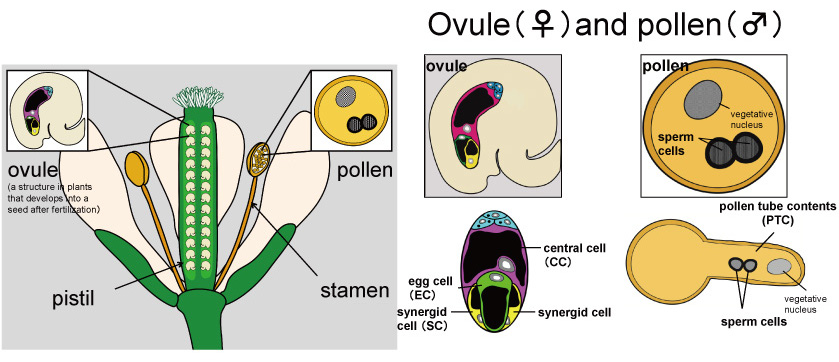
Structure of a flower, consisting of a pistil (female part) in the center and stamen (male part) on each side. The pistil has ovules containing egg cells, and the stamen consists of pollen containing sperm cells.
 About the research:
About the research:
Nagoya, Japan - Dr. Ryushiro Kasahara (photo), Professor Tetsuya Higashiyama of the Institute of Transformative Bio-Molecules (ITbM) of Nagoya University and their colleagues have reported in Science Advances, on the discovery of a new plant phenomenon where the pollen tube contents (PTCs) trigger seed enlargement in the absence of fertilization.
Upon pollination, pollen grows pollen tubes inside the pistil, in order to deliver its sperm cells (male) to the egg cells (female) located inside the ovules (Figure 1). Although PTCs have been known to exist inside the pollen tube along with sperm cells, its actual function has been unknown for a long time.
In animals, the function of the seminal fluid (containing sperm cells), which is in a similar position to PTCs in plants, has been well studied. Research in mice shows that when a particular protein is removed from the seminal fluid, the sperm cell is unable to induce fertilization, thus indicating that the seminal fluid is essential for fertilization to occur in animals.
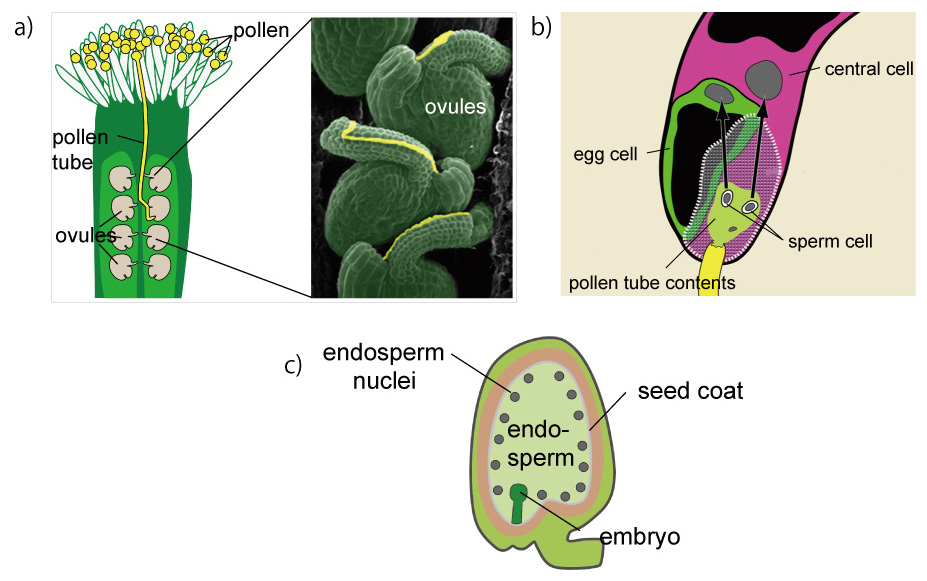
Figure 1. a) Growth of pollen tube towards the ovule. Sperm cells exist at the tip of the tube. Pollen tube contents (PTC) are the liquid part of the pollen tube, shown in yellow. b) Upon pollination to the pistil, the pollen tube grows from pollen towards the ovule. Once the pollen tube reaches the ovule, the tube bursts releasing PTCs and two sperm cells that can fertilize the egg cell and the central cell. Yellow lines on the ovule after fertilization (seed) in figure 1. a) show the pathway taken by the pollen tube. c) A seed after fertilization. After fertilization, the egg cell and central cell develop into the embryo and the endosperm, respectively. Simultaneously, the ovule develops a seed coat.
Ryushiro Kasahara, a leader of this research, decided to look into the function of PTCs to see if it has a similar function to the seminal fluid in animals. He conducted hybridization experiments using mutants of a model plant Arabidopsis thaliana that can release PTCs into the ovule even when fertilization does not occur (Figure 2).
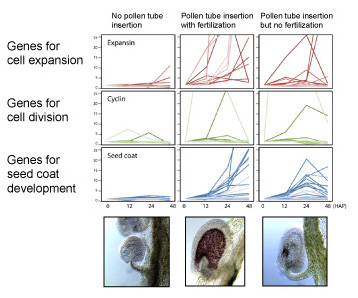
Figure 2. Temporal expression of genes. Each graph shows the strength of gene expression (y-axis) versus the hours after pollination (HAP; x-axis). The graph on the right hand row shows the gene expression of pollen tube insertion without fertilization. The results indicate that despite the absence of fertilization, gene expression of cell expansion, division and seed coat development is observed in some cases.
As a result, his group found that ovules subjected to PTCs without fertilization lead to cell division, along with enlargement of the seed. In addition, formation of the seed coat and endosperm was also observed. For years, it has been considered that ovule enlargement only occurs upon fertilization. Nevertheless, Kasahara's new discoveries show that PTCs alone can induce ovule enlargement, which breaks the common principle that fertilization is essential for seed development.
"The most difficult part of this research was to make sure that fertilization does not occur in order to identify the function of PTCs," says Kasahara. "I was extremely excited when I saw that PTCs alone led to seed development without fertilization."
Reproduction in plants starts from pollination on the pistil, followed by pollen tube guidance, which eventually leads to fertilization. This research demonstrates the existence of an unexplored step between pollen tube guidance and fertilization, where PTCs have a major role in seed development.
In crops, such as rice, corn and wheat, the parts that we mainly eat are the endosperm in the seed. By further elucidation on the function of the PTCs, as well as development of new technology to apply PTCs to plants, it may become possible to produce crops that can form the endosperm without fertilization. As the fertilization rate becomes relatively low under unfavorable or unusual weather conditions (e.g. typhoon and high temperatures) during the flowering season, this has drastic effects on crop production. If endosperms can form by application of the key molecules in PTCs, without the need for fertilization, this may be useful in producing crops that are unaffected by climate conditions.
Initially, Kasahara and his colleagues investigated what kind of genes is expressed in ovules that have accepted PTCs, by analyzing the genes in Arabidopsis thaliana. They carried out experiments using mutants that do not necessarily fertilize upon pollination.
"We found that ovules that have accepted PTCs, undergone fertilization and have developed an embryo and endosperm, show expression of genes that are essential for embryo and endosperm formation," explains Kasahara. "On the other hand, ovules that have accepted PTCs but have not been fertilized did not show gene expression of the embryo and the endosperm. We were surprised to see that this unfertilized ovule showed expression of genes that induce cell expansion and division, as well as seed coat formation."
From the results of gene expression, Kasahara hypothesized that the division and enlargement of ovules, as well as seed coat formation can occur without fertilization. Therefore, he decided to look into the gene expression of ovules (Figure 3).
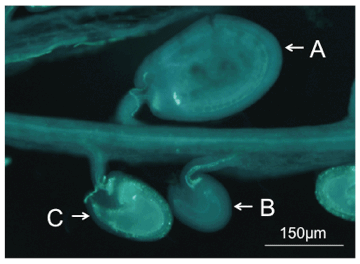
Figure 3. Discovery of POEM. (A) An ovule inserted with a pollen tube that can fertilize. Ovule enlargement is observed upon fertilization. (B) An ovule without insertion of a pollen tube. Without insertion of a pollen tube, ovule enlargement is not observed. (C) An ovule inserted with a pollen tube that cannot fertilize. Even though fertilization has not occurred, ovule enlargement is observed due to release of PTCs into the ovule. Upon analyzing 100 ovules inserted with pollen tubes that cannot fertilize, the ovule size was on average, 2.5 times larger relative to ovules without insertion of a pollen tube.
"We found that ovules with the insertion of pollen tubes but without fertilization are on average 2.5 times larger that those without the insertion of pollen tubes. The unfertilized ovules with pollen tube insertion also showed seed coat formation," says Kasahara. "This new observation overturns the common principle that ovules need to fertilize for enlargement to occur." (Figure 4)
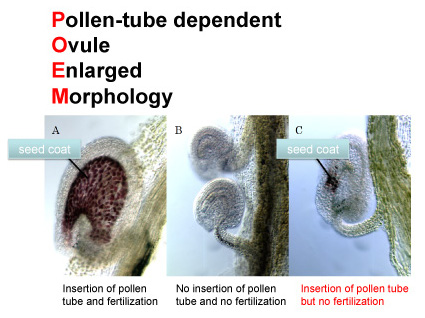
Figure 4. Seed coat formation from POEM. (A) An ovule inserted with a pollen tube that can fertilize. Seed coat formation is observed upon fertilization. (B) An ovule without insertion of a pollen tube. No seed coat formation is observed in the absence of pollen tube insertion. (C) An ovule inserted with a pollen tube that cannot fertilize. Even though fertilization has not occurred, seed coat formation is observed due to release of PTC into the ovule.
Kasahara was then able to confirm through further experiments that PTCs were responsible for ovule enlargement. By using mutants where pollen tubes burst at a certain rate and release PTCs, they compared to ratio of ovules that increased in size without fertilization, to the ovules where the pollen tube ruptures and releases PTCs.
"We were delighted to see that the percentage of ovules that become enlarged and the percentage of ovules accepting PTCs showed a good match," describes Kasahara. "This shows evidence that PTCs contribute to ovule enlargement." Kasahara named this new phenomenon, POEM, which stands for "pollen tube dependent ovule enlargement morphology". (Figure 5)
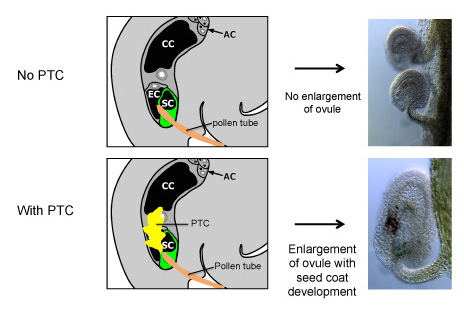
Figure 5. (Top) When PTC is not released into the ovule, ovule enlargement is not observed. Even if the pollen tube becomes inserted into the ovule, ovule enlargement does not happen without PTC. (Bottom) Upon release of PTC, ovule enlargement and seed coat formation is observed regardless of fertilization.
Upon using a mutant that generates an endosperm without fertilization, the rate of autonomous endosperm formation was below 3% without PTCs. On the other hand, when PTCs were released into the ovule, 50% of the ovules autonomously formed an endosperm. This indicates that PTCs are able to increase the probability of endosperm formation in ovules (Figure 6).
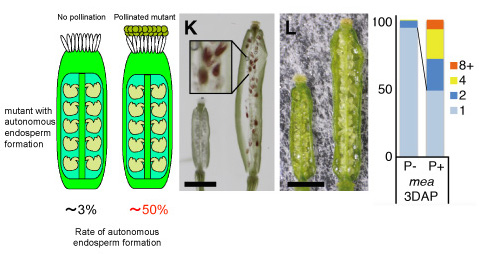
Figure 6. (Left) Pistil of an autonomous endosperm formation mutant with no pollination. Autonomous endosperm formation has not occurred in this mutant. (Right) Pistil of an autonomous endosperm formation mutant pollinated with pollen that cannot induce fertilization. The parts colored in red are the seed coats and indicate endosperm development. Once the PTC enters within the ovule, autonomous endosperm formation was observed in many ovules. Autonomous endosperm formation mutants show that upon the action of PTC, endosperm formation is initiated without fertilization.
"We are currently interested in what kind of molecules in the PTCs are responsible for triggering POEM," says Kasahara. "We hope we can find key molecules, which can be constantly expressed in ovules so that the endosperm can be formed without fertilization. This is expected to be highly useful for producing crops in various climates, where fertilization does not readily occur."
Journal Information
This article "Pollen tube contents initiate ovule enlargement and enhance seed coat development without fertilization" by Ryushiro D. Kasahara, Michitaka Notaguchi, Shiori Nagahara, Takamasa Suzuki, Daichi Susaki, Yujiro Honma, Daisuke Maruyama, Tetsuya Higashiyama is published online in Science Advances.
DOI: 10.1126/sciadv.1600554